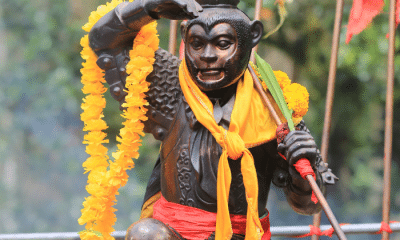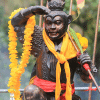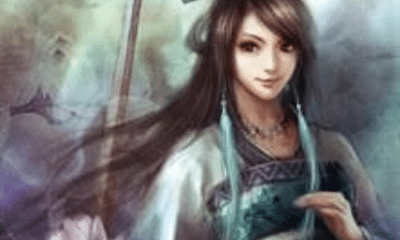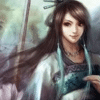Chinese
Mythical Sea Dragons from Around the World
Dragons are some of the most iconic monsters of modern fantasy, but their origins are ancient. Keep reading to learn about how many cultures viewed the dragons that lived in the sea.
Modern fantasy has given many people a very definite idea of what a dragon is like. They are widely depicted as large, intelligent, winged reptiles with furious tempers and a love of gold.
This idea of the dragon is only one of many that have existed throughout history, however. Nearly every culture in the world has had its own ideas about these serpentine beasts.
While most modern depictions show dragons living in caves and flying through the air, in many ancient cultures they were creatures of the sea. While the most familiar example of this type are the dragons of Chinese folklore, many cultures had their own mythical sea dragons.
The mythical sea dragons of the world all had their own meanings and imagery, but they also had a lot in common!
The Dragons of Chinese Mythology
Dragons are among the most iconic creatures of Chinese culture. In art, festivals, and even the zodiac the dragon still features prominently.
Chinese dragons occasionally had the features of turtles or fish, but most were serpentine. They have long bodies, four legs, fearsome faces, and often large horns.
Archaeology shows that similar creatures were depicted in art as early as the 5th millennium BC. By the time of the Emperors, dragons were regarded as the highest-ranking animals in creation.
Dragons were thought of as wise, physically strong, and noble creatures. People who were considered to have these traits were compared to dragons, while the weak and immoral were compared to lowly animals like worms and insects.
The association with dragons and greatness led to them being adopted as a symbol of imperial authority. Many emperors featured dragons in their official imagery, including architecture.
Some of the myths regarding dragons reinforce the link between them and the ruling class.
Dozens, if not hundreds, of myths from different parts of China featured dragons. Some of these were in laudable roles, while others were villains.
One well-known legend connected dragons directly to both imperial power and Chinese culture.
The Yellow Emperor was believed to have been the first ruler of China. He was the first to spread animal domestication, building, agriculture, and other foundations of culture.
The Yellow Emperor ruled for a hundred years before dying and passing on his throne to his son. After his life, he was immortalized as a dragon that resembled his imperial emblem.
As the Yellow Dragon, he was at the center of creation. He was also the ancestor of the Han Chinese and their culture, leading many to call themselves “Children of the Dragon.”
Dragons in Chinese mythology were god-like figures. As deities, they were closely linked to water.
While other cultures had gods or nymphs that were associated with bodies of water, the Chinese believed that the water was ruled by the Dragon Kings.
Local rivers and waterfalls each had their own dragon king. The people nearby would offer prayers and sacrifices to these dragons to ensure their good favor and prevent floods and droughts.
In folklore, slaying troublesome dragons was often used as a metaphor for controlling the waterways. Dams, irrigation networks, and drainage systems were all seen as ways of destroying or taming a dragon that had once caused floods and hardship.
The most prominent dragons, however, were the four dragon kings who ruled the seas. Corresponding to the four cardinal directions and four colors, they were among the most powerful deities in Chinese mythology.
These mythical sea dragons were gods of their realms. They each appeared in many works of literature, where they were both powerful deities and antagonists.
The dragon kings, often combined under the singular name of the Dragon King, were gods of weather. They brought rain, floods, and drought when angered, but could also be helpful when appealed to.
The dragon kings were sometimes shown in human form, but were often serpentine dragons. They embodied masculinity and qi energy.
These marine dragons continue to be important in Chinese culture. Dragon boat races take place during some festivals, while celebrations like the Lunar New Year are marked with dragon dances in which people parade with elaborately constructed dragon figures.
Chinese-style dragons also spread to other parts of Asia. China’s cultural influence over the course of thousands of years led to mythical sea dragons being important in the cultures of Korea, Japan, Vietnam, and other East Asian countries.
Egypt and the Near East
Outside of China, mythical sea dragons were more often seen as the enemies of the god than as gods themselves.
One of the earliest examples of a possible sea dragon in the West is in Egyptian mythology. There, the dragon is directly linked to the Underworld.
According to Egyptian myths, the sun god Ra traveled by boat through the sky. Each night, he went over the western edge of the world and descended into Duat, the Underworld.
While he sailed through the Underworld, Ra was confronted by many demons and monsters. The most powerful of these was Apep.
Described by one of the most conservative sources as 16-meters long, Apep was an enormous serpent. Representing the forces of chaos and darkness, each night he tried to kill Ra so the sun would never rise again.
Apep was usually depicted in art as an enormous serpent twisting beneath Ra’s boat. He was sometimes called the Serpent from the Nile or the Evil Dragon.
The battles between the gods who helped Ra on his journey and Apep were often used to explain natural phenomena. Thunderstorms and earthquakes, both linked to sea creatures elsewhere, were blamed on the Underworld serpent.
Apep’s size and the scope of his power led to him sometimes being described as “world-encircling.” He was likely linked to another image that originated in ancient Egypt.
The ouroboros was a symbol that came from Egypt and was later adopted by many other cultures. It is of a great serpent that bites its own tale, forming a complete circle.
While the ouroboros itself was not a sea dragon, its form became a common way of representing such beasts in later cultures.
In the Near East, there were many creatures in mythology that resembled what later cultures would call dragons. While some were associated with storms, most were land animals.
The Canaanites, however, believed that a great serpent called Lotan had been defeated in prehistory by the storm god Ba’al. Lotan was a servant of the sea god Yam, Ba’al’s adversary.
While Lotan is not familiar to many modern audiences, more people have heard of the Biblical monster the story inspired.
Influenced by Canaanite lore, the Isrealites created the Leviathan. In the Book of Psalms, this great serpent is defeated by Yahweh.
While some books of the Bible imply that the Leviathan, like Lotan, was defeated at the beginning of time, others imply that the monster was only subdued. It would only truly be defeated at the end of the current age.
The sea dragon of the Bible will be destroyed for good, according to the Book of Isaiah, when Israel’s enemies are defeated by the Messiah.
Greek Drakaines and Sea Monsters
Greek and Roman mythology, probably influenced by the cultures of the Near East, also featured many sea dragons.
Many monsters in Greek mythology had attributes of serpents, and as a sea-faring culture a majority of these monsters were connected in some way to water. This made the existence of dragon-like creatures a recurring theme in Greek lore.
In fact, the English word “dragon” can be traced to these myths. Such serpents were called drakaines in the Greek language.
Many of these drakaines were female monsters. They not only threatened the gods and men, but were also the mothers of other types of monsters and beasts.
While many of these drakaines had only some serpentine features, a majority were seen as sea monsters. Creatures like Echidna, Lamia, and Scylla were all connected to powers of the sea.
More closely resembling the modern idea of a sea dragon, however, were the cetea.
The cetea were sea monsters who were, most often, in the service of Poseidon. He used them in several stories to punish seaside cities that had incurred his wrath.
The most famous cetus, for example, was killed by Perseus as he returned from killing another monster with snake-like features, the Gorgon Medusa.
The cetus that attacked Ethiopia in this instance had been sent by Poseidon on behalf of the nymphs who lived in the sea. When the Ethiopian queen had bragged that her daughter, Andromeda, was more beautiful than the nymphs, Poseidon had punished the kingdom for her hubris.
Another famous cetus was sent against the city of Troy. In this case, Poseidon was punishing the people there for their king’s refusal to pay a debt owed to the god.
The stories of the cetea often followed a familiar formula. Poseidon sent the monster and a great flood to a city with an arrogant or impious ruler.
The floods created their own destruction, but they also gave the sea monster access to the city and the countryside around it. The cetus hunted the people of the city and used its great size to destroy buildings and farmland.
In both of these stories, oracles said that the only way to stop the monster’s rampage was to sacrifice a maiden, the king’s daughter in both Ethiopia and Troy. She was tied to the rocks by the sea, but was rescued by a hero who killed the cetus and saved the city from its curse.
Sailors sometimes claimed to see the cetea deep in the water. Although they rarely got a close look at them, they sometimes described large shapes beneath the waves or a sighting of a massive creature’s back emerging from the surface of the water.
The cetea were sometimes shown in art as enormous fish, but in other cases they looked more like true sea dragons. They had long serpentine bodies, dog-like heads, and pointed ears or horns. While Chinese dragons had legs, Greek cetea had fin-like limbs.
The cetea were destructive and terrifying, but they were also shown as more mundane animals in the world that was imagined to exist in the sea. Nereid sea nymphs sometimes rode them like horses and one writer said that they were not inherently evil, but their size and strength made them destructive.
Jormungandr
One of the most iconic mythical sea dragons in European lore was Jormungandr. The great serpent of Norse mythology combined the most dangerous elements of sea dragons from around the world.
Jormungandr was one of the monstrous offspring of Loki, the Norse trickster god. From the beginning, he and his siblings were destined to be enemies of the gods.
When Loki’s children were discovered by the gods, each was banished to a place where it was hoped they would no longer be a threat. The wolf Fenrir was chained, Hel became the queen of the Underworld, and Jormungandr was thrown into the depths of the sea.
Jormungandr was also known as the World Serpent. He was said to be so large that he filled the entire sea and encircled Midgard, the world of men.
The imagery of Jormungandr was likely inspired by the ouroboros, which had been brought to Europe through Greek and Roman contact with Egypt. He was often shown as being so large that the only way he fit in the sea was by biting his own tail.
Like Near Eastern monsters, the Germanic sea dragon was also the enemy of the storm god. He had two encounters with Thor over the course of the storm god’s life.
In one story, Thor and a giant went fishing. Despite being in a small boat, Thor insisted on rowing far out to sea.
His companion, Hymir, was surprised when the thunder god used the head of his largest ox as bait. Even after catching two whales, Thor insisted on going out further.
Finally, Thor got a bite. He used all his strength to pull in his line and succeeded in pulling only Jormungandr’s massive head out of the water.
Thor reached for Mjolnir, his great hammer, to kill the sea dragon. Before he could strike a blow, however, the terrified Hymir cut the line and Jormungandr disappeared beneath the waves.
In another story, the giant Uthgard-Loki challenged Thor to a test of strength. He set the god with the seemingly-simple task of picking up his pet cat.
When the famously strong god reached for the cat, however, he could barely move it. Using all of his power, he only managed to lift one of its paws off the floor.
Still, Uthgard-Loki applauded Thor’s effort. The cat had actually been Jormungandr, magically disguised. Lifting a fraction of its enormous weight was an impressive feat.
Of course, the greatest conflict between Thor and the World Serpent was yet to come, according to Norse mythology. The two would face off at Ragnarok, the last battle of the gods.
Before the battle, Jormungandr would haul himself onto dry land. Already ravaged by years of winter and warfare, many places would be crushed under his weight or destroyed by the tidal waves he caused.
When the gods went to battle, Thor and the sea dragon would fight one another. The duel would be so difficult that Thor would be unable to help any of the other gods as they battled their own opponents.
Thor would finally succeed in killing the great serpent and would turn his attention to the fight between his father, Odin, and Fenrir. He would only be able to take a few steps, however, before falling dead due to the dragon’s venom.
My Modern Interpretation
Around the world, serpents were connected to the water and rain. So why did so many cultures develop these ideas?
Historians have offered many practical explanations for the creation of sea serpents in so many different cultures.
One of the most common ideas is that these monsters were based, in part, on real animals.
In Greece, for example, the word cetus did not only apply to a dragon-like creature. It could be used to mean any large animal that was spotted at sea.
Because of this, whales and sharks were called cetea as well. This explains why such creatures were sometimes shown as massive fish in art.
Many supposed sightings of sea monsters can be attributed to the brief glimpses sailors occasionally got of unknown marine life. In addition to whales, some believe that animals like squid inspired some stories of sea monsters.
Another theory is supported by some ancient documents.
In 300 BC, a Chinese writer documented the discovery of “dragon bones” in Sichuan province. Most modern historians believe that these were actually dinosaur bones.
Well-preserved dinosaur remains would have shown features of familiar reptile species but on a much larger scale. These could have easily inspired the imagery of massive animals that resembled snakes or lizards.
The connection between dragons and dinosaurs is still seen in China today. In some rural areas, fossils are still used in traditional medicine under the name “dragon bones.”
Linguistically, the Chinese word for dinosaur is written with the characters for “terror dragon.” Many extinct species discovered in Asia have been given the binomial name mei long, or “sleeping dragon.”
Both of these theories likely provided some basis for the idea of an enormous serpent or lizard. Fossil remains may have inspired the shape, while sightings of real animals led to the belief that enormous monsters lived in the water.
The similarities between the world’s mythical sea dragons are likely in part due to the ways in which they developed. Cultural exchange also encouraged the spread of the form.
The Leviathan, for example, was directly inspired by the Canaanite Lotan. It, in turn, was compared to Jormungandr when Christianity spread to Northern Europe.
While sea dragons are no longer the most popular form of the mythical beast, ancient myths of serpents of the water continue to inspire modern ideas. St. George’s legend originated with Perseus slaying the cetus of Ethiopia, fantasy monsters have the form of draikones, and the image of the dragon is synonymous with East Asian culture.





